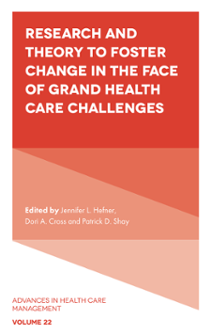
Index
Research and Theory to Foster Change in the Face of Grand Health Care Challenges
ISBN: 978-1-83797-656-0, eISBN: 978-1-83797-655-3
ISSN: 1474-8231
Publication date: 7 February 2024
Citation
(2024), "Index", Hefner, J.L., Cross, D.A. and Shay, P.D. (Ed.) Research and Theory to Foster Change in the Face of Grand Health Care Challenges (Advances in Health Care Management, Vol. 22), Emerald Publishing Limited, Leeds, pp. 239-247. https://doi.org/10.1108/S1474-823120240000022018
Publisher
:Emerald Publishing Limited
Copyright © 2024 Jennifer L. Hefner, Dori A. Cross and Patrick D. Shay. Published under exclusive licence by Emerald Publishing Limited
INDEX
- Prelims
- Section 1 Persistent Drivers of Environmental Uncertainty
- Chapter 1 Back to the Future: What Healthcare Organizations Need to Thrive in the Face of Persistent Environmental Uncertainty
- Chapter 2 Measure Twice, Change Once: Using Simulation to Support Change Management in Rural Healthcare Delivery
- Chapter 3 Examining Knowledge Management and the Culture Change Movement in Long-Term Care: A Study of High-Medicaid-Census Nursing Homes
- Section 2 Mechanisms of Change – How Leaders Within Organizations Frame and Execute Change
- Chapter 4 Toward a Theory of Organizational DNA: Routines, Principles, and Beliefs (RPBs) for Successful and Sustainable Organizational Change
- Chapter 5 Innovation Diffusion Across 13 Specialties and Associated Clinician Characteristics
- Chapter 6 Safe Surgery Checklist Implementation: Associations of Management Practice and Safety Culture Change
- Section 3 Organizational Preparedness and Response in the Face of Acute Crisis
- Chapter 7 Hospital Finances During the First Two Years of the COVID-19 Pandemic: Evidence From Washington State Hospitals
- Chapter 8 Sustaining Preparedness in Hospitals
- Section 4 Sociopolitical and Demographic Shifts Require Preparedness Outside of Acute Crisis
- Chapter 9 The Coproduction of Health Framework: Seeking Instructive Management Models and Theories
- Chapter 10 Perceived Value of the Inclusion of Parent-to-Parent Support in Case Conferences and Care Planning for Children With Special Healthcare Needs
- Chapter 11 Organizational and Policy Challenges and Priorities for Integrating Family Care Partners Into the Healthcare Team
- Index